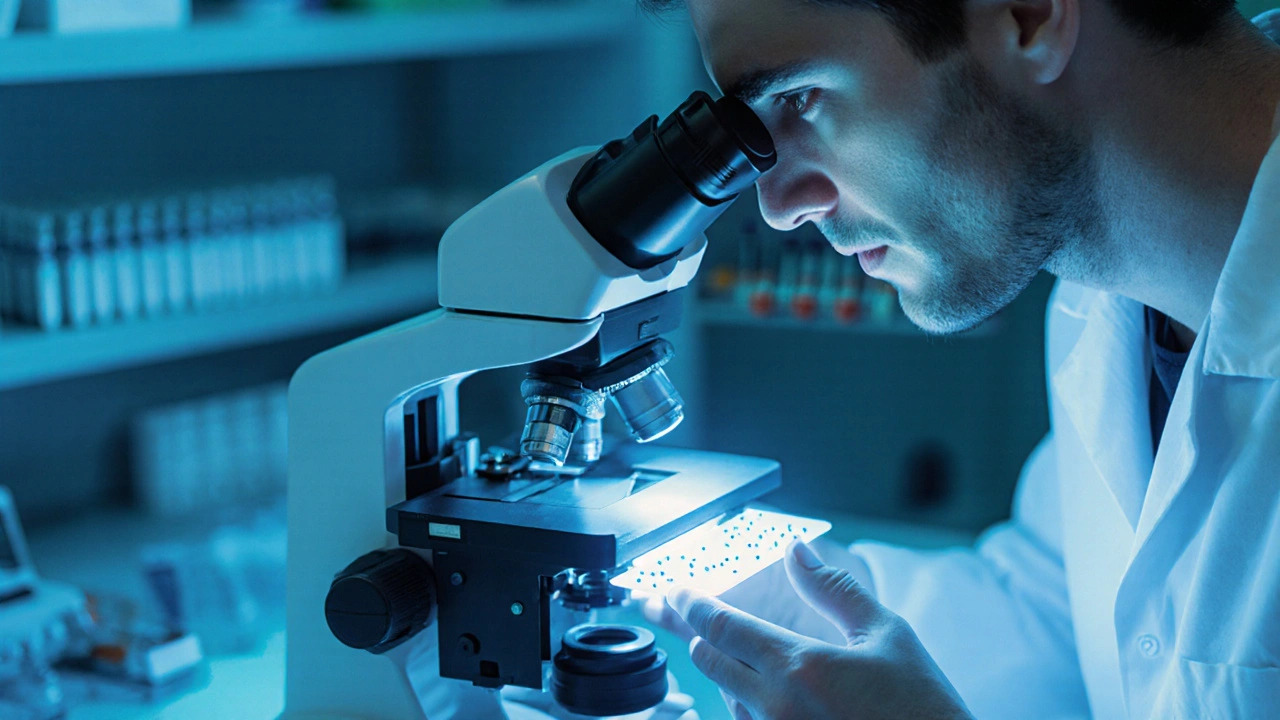27 Sep 2025
- 10 Comments
Secondary hypogonadism is a medical condition in which the testes produce insufficient testosterone because of problems higher up in the hypothalamic‑pituitary‑testicular (HPT) axis. Unlike primary hypogonadism, the testicles themselves are usually normal; the fault lies with the brain or pituitary gland, often leading to low sperm output and infertility.
Why Secondary Hypogonadism Impacts Fertility
The HPT axis regulates both testosterone and the production of the sperm‑stimulating hormones follicle‑stimulating hormone (FSH) and luteinizing hormone (LH). When the pituitary fails to release enough LH and FSH, testosterone drops and spermatogenesis stalls. This double‑hit explains why men with secondary hypogonadism frequently present with low infertility the inability to achieve a pregnancy after one year of regular, unprotected intercourse despite having otherwise healthy testes.
Core Diagnostic Checklist
- Morning serum testosterone (< 300ng/dL is typical for secondary cases).
- Serum LH and FSH - both usually < 5IU/L in secondary hypogonadism.
- Prolactin and thyroid panels - to rule out secondary causes like pituitary adenoma or hypothyroidism.
- Semen analysis - often shows oligozoospermia (sperm count <15million/mL) or azoospermia.
- Imaging (MRI of pituitary) when a tumor is suspected.
Treatment Landscape Overview
Choosing a therapy hinges on three questions: 1) Does the man want to restore natural testosterone production? 2) Is sperm production a priority? 3) What underlying cause drives the hypogonadism? Below are the five most common routes, each with its own success profile.
| Option | Mechanism | Typical Pregnancy Success Rate | Key Monitoring |
|---|---|---|---|
| Testosterone Replacement Therapy (TRT) exogenous testosterone to normalize serum levels | Suppresses LH/FSH - improves symptoms but often reduces sperm output | ~5% (only if combined with gonadotropins later) | Serum testosterone, hematocrit, prostate health |
| Gonadotropin Therapy hCG mimics LH; recombinant FSH stimulates Sertoli cells | Restores endogenous testosterone & sperm production | 30‑45% (varies with duration, age) | Sperm count, testosterone, testicular volume |
| Clomiphene Citrate selective estrogen receptor modulator that boosts LH/FSH | Increases endogenous hormone release without suppressing spermatogenesis | ≈20‑25% | LH/FSH levels, sperm parameters, liver function |
| Aromatase Inhibitors (e.g., Anastrozole) reduce estrogen conversion, lifting negative feedback on LH/FSH | Raises testosterone modestly; may improve sperm in obese men | ≈15‑20% | Estradiol, testosterone, bone density |
| Assisted Reproductive Technology (ART) IVF/ICSI using retrieved sperm or donor sperm | Bypasses natural sperm production; used when other therapies fail | 50‑70% per cycle (depends on female partner) | Ovarian reserve, embryo quality, sperm retrieval success |
1. Testosterone Replacement Therapy (TRT)
TRT is the go‑to for men craving energy, libido, and mood boost. The usual regimen is a transdermal gel (50‑100mg daily) or intramuscular injections (100‑200mg every 2‑3weeks). While serum testosterone often normalizes within weeks, the feedback loop tells the pituitary to cut back LH and FSH, which can push sperm counts to zero.
If the primary goal is fertilization, TRT alone is rarely satisfactory. Some clinics pair TRT with hCG human chorionic gonadotropin, a LH analog after a wash‑out period to rekindle intratesticular testosterone and restore spermatogenesis. Studies from 2023‑2024 show a combined approach yields a 12‑month pregnancy rate of about 10%-still modest but better than TRT alone.
2. Gonadotropin Therapy
When the aim is a natural conception, hCG+FSH is the gold standard. The protocol typically starts with hCG 1,500‑2,000IU subcutaneously three times per week, combined with recombinant FSH 75‑150IU two to three times weekly. After 3‑6months, many men see testicular volume rise from 12mL to 18‑20mL and sperm concentrations climb into the fertile range (>15million/mL).
Real‑world data from the Male Reproductive Endocrinology Society (2024) reports an overall live‑birth rate of 38% after 12months of therapy, with higher success in men under 35 and those without concurrent pituitary lesions.
3. Clomiphene Citrate
Clomiphene is taken orally, usually 25‑50mg every other day. It blocks estrogen receptors in the hypothalamus, nudging the pituitary to secrete more LH and FSH. The advantages are convenience and preservation of testicular size. However, response rates plateau around 20‑25% for live births, and some men experience visual disturbances or mood swings.
A 2022 multicenter trial involving 312 men showed that adding low‑dose hCG (500IU weekly) to clomiphene improved sperm concentration by 30% and boosted pregnancy rates to 32%.

4. Aromatase Inhibitors (Anastrozole)
Aromatase inhibitors target the conversion of testosterone to estradiol, which often suppresses LH/FSH in obese or insulin‑resistant men. The typical dose is 1mg every other day. Results are mixed: while testosterone may rise 100‑150ng/dL, sperm counts only improve in roughly one‑third of patients.
Researchers at the University of Chicago (2023) noted that men with baseline estradiol >40pg/mL responded best, achieving a 22% live‑birth rate after 9months of therapy.
5. Assisted Reproductive Technology (ART)
When medical therapy stalls, ART steps in. Sperm can be retrieved directly from the epididymis (MESA) or testis (TESE) even if a man is azoospermic after hormone treatment. The retrieved sperm are then used for IVF with intracytoplasmic sperm injection (ICSI). Success hinges on female partner factors, but overall live‑birth rates per cycle sit between 50‑70% in specialist centers.
Importantly, ART does not correct the underlying hormonal deficit. Men often continue TRT or other hormonal management for symptom relief after successful conception.
Personalizing the Choice
Below is a quick decision guide:
- Desire for natural conception and good baseline sperm count: start with gonadotropin therapy.
- Low libido dominant, okay with assisted conception: TRT for symptom control plus ART.
- Obesity or high estradiol: consider aromatase inhibitors, possibly combined with clomiphene.
- Cost‑sensitive and prefers pills: clomiphene or low‑dose aromatase inhibitor.
- Previous pituitary tumor surgery: evaluate hormone levels; often gonadotropins work best post‑surgery.
Monitoring & Safety Tips
Regardless of therapy, regular follow‑up is crucial. Typical schedule:
- Baseline labs: testosterone, LH, FSH, estradiol, prolactin, CBC, lipid panel.
- Every 3months: repeat hormones, semen analysis, testicular ultrasound if volume doesn’t rise.
- Every 6months: cardiovascular risk assessment (BP, HbA1c) - testosterone can affect lipid profiles.
- Annual: prostate-specific antigen (PSA) if >40yr and no contraindications.
Side‑effects to watch for include polycythemia (high hematocrit) with TRT, gynecomastia with aromatase inhibitors, and mood changes with clomiphene.
Future Directions
Emerging therapies like selective androgen receptor modulators (SARMs) aim to boost muscle and libido without suppressing LH/FSH. Early phase‑II trials show promising testosterone rises and modest sperm improvements, but long‑term fertility data are still pending.
Gene‑editing approaches (CRISPR‑based) are being explored for rare congenital forms of secondary hypogonadism, yet they remain experimental and far from clinical use.
Take‑away Checklist
- Confirm diagnosis with hormone panel and semen analysis. \n
- Identify underlying cause (tumor, medication, obesity).
- Choose therapy based on fertility goal, age, and personal preference.
- Monitor hormones, sperm parameters, and health markers every 3‑6months.
- Consider ART if natural conception does not occur after 12‑18months of optimal medical therapy.

Frequently Asked Questions
Can testosterone replacement therapy improve sperm count?
TRT generally *lowers* sperm production because it tells the pituitary to stop making LH and FSH. Some clinics pair TRT with hCG after a short wash‑out, which can restore intratesticular testosterone and modestly improve sperm, but TRT alone is not a fertility solution.
How long does gonadotropin therapy take to show results?
Most men see a rise in testicular volume and sperm concentration within 3‑6months. Full normalization can take up to a year, so patience and consistent monitoring are key.
Is clomiphene safe for long‑term use?
Clomiphene is generally well‑tolerated, but long‑term users may experience visual disturbances, mood swings, or liver enzyme changes. Annual eye exams and liver function tests are advisable.
When should I consider moving to assisted reproductive technology?
If after 12-18months of optimal medical therapy (gonadotropins, clomiphene, or aromatase inhibitors) you haven’t achieved a pregnancy, or if sperm counts remain <5million/mL, ART such as IVF/ICSI becomes a realistic next step.
Do lifestyle changes affect secondary hypogonadism?
Yes. Weight loss, regular exercise, and reducing alcohol can lower estradiol levels, improve LH/FSH secretion, and boost both testosterone and sperm quality, especially in obesity‑related cases.


Ajayi samson
September 27, 2025Look, the article tries to sound comprehensive but it glosses over the biggest flaw: it treats secondary hypogonadism as a simple hormone deficit when, in reality, the pituitary axis is a tangled web of feedback loops. The numbers they quote for live‑birth rates are cherry‑picked from idealized centres, not the average urology clinic. If you’re a patient reading this, you’ll be misled into thinking a cheap clomiphene pill will solve everything. The piece also ignores the cost and the emotional toll of long‑term gonadotropin injections. Bottom line: read between the lines and demand more rigorous data before jumping on any regimen.
Sadie Bell
September 28, 2025Hey everyone, this is a solid rundown of the options and it’s great to see the focus on personalized care. For anyone feeling overwhelmed, remember that you don’t have to navigate this alone-talk to a fertility specialist who can map out a step‑by‑step plan. Even small lifestyle tweaks like weight loss can amplify the effects of medication. Keep the momentum, stay hopeful, and trust the process.
Holly Hayes
September 28, 2025this is just basic biology folks its not rocket science anyone who ignores the hormone feedback is basically ignoring common sense the article could have mentioned that simple diet changes can actually make a dent
Anshul Gandhi
September 29, 2025The so‑called "evidence‑based" rates presented in this post are a carefully curated illusion crafted by a coalition of pharma lobbyists and fertility clinics. They hide the fact that most men on clomiphene never achieve a pregnancy despite the glossy 30% figure. The hidden agenda is to push low‑cost oral agents while keeping the more lucrative gonadotropin injections out of the public eye. Moreover, the article never addresses the clandestine use of off‑label hCG protocols that are being suppressed by regulatory bodies. You’ll also notice the omission of the long‑term oncogenic risks associated with chronic estrogen blockade, a topic deliberately omitted from mainstream discussions. The data from the Male Reproductive Endocrinology Society is selectively quoted, ignoring the subgroup that suffered severe visual disturbances and mood disorders. If you dig into the raw trial registries, you’ll see a dropout rate exceeding 40%, which completely skews the live‑birth outcome. The piece also pretends that aromatase inhibitors are safe, yet there are multiple case reports of bone density loss in men under 40. And don’t even get me started on the covert financial ties between the authors of these studies and the manufacturers of clomiphene. The “future directions” section is a thinly veiled marketing pitch for SARMs, which are still experimental and have unknown reproductive side effects. You should be wary of any recommendation that doesn’t include a thorough discussion of the underlying pituitary pathology. The claim that ART “does not correct the hormonal deficit” is true, but the article conveniently omits that many clinics push ART as a first‑line solution to maximize profit. In reality, the success of IVF/ICSI hinges more on the female partner’s age than on the modest sperm improvements these drugs offer. The whole narrative is engineered to keep men on a lifetime of medication, monitoring, and expensive procedures. I recommend consulting independent endocrinology forums where patients share unfiltered outcomes and adverse events. Until the hidden data is brought to light, treat this article as a PR brochure rather than a medical guideline.
Emily Wang
September 29, 2025Alright, let’s cut to the chase: if you’re over 35 and still clinging to pills, you’re probably wasting a ton of time. Gonadotropin therapy has the highest odds, but it’s also the most expensive and invasive, so be ready for injections and regular blood draws. Combine it with lifestyle changes-lose that extra weight, cut down on alcohol, and watch your estradiol drop. Don’t ignore the mental health side effects; mood swings can sabotage your efforts as much as the hormones themselves. Stay disciplined, track every metric, and you’ll see real progress.
Craig Hoffman
September 30, 2025Actually, the consensus from multiple societies is that clomiphene remains a first‑line oral option for many men. The live‑birth rates quoted are averages and individual response can vary widely. It’s best to individualize therapy based on baseline labs and patient preference.
Terry Duke
September 30, 2025Wow, you’ve laid out a solid roadmap, Emily, and I totally agree-tracking everything is key, especially when you’re juggling injections, diet, and the inevitable stress that comes with it; remember to schedule regular check‑ins with your endocrinologist, keep a log of mood changes, and don’t forget to celebrate the small wins along the way, because those milestones keep the motivation high!
Chester Bennett
September 30, 2025Holly, you’re right that the physiology is straightforward, but the clinical management often requires nuanced decisions. A comprehensive hormone panel, including prolactin and thyroid function, helps differentiate secondary causes. Tailoring therapy to the individual’s baseline values improves outcomes. Let’s keep the discussion evidence‑based.
Hayden Kuhtze
October 1, 2025Oh, look, another article that thinks “a few pills” magically fix a complex endocrine disorder. It’s adorable how they gloss over the fact that the hypothalamic‑pituitary axis isn’t a DIY project. Perhaps next time they’ll mention the importance of a proper endocrine work‑up before prescribing clomiphene. Until then, enjoy the oversimplified advice.
Debra Cine
October 1, 2025Great info, keep sharing! 😊